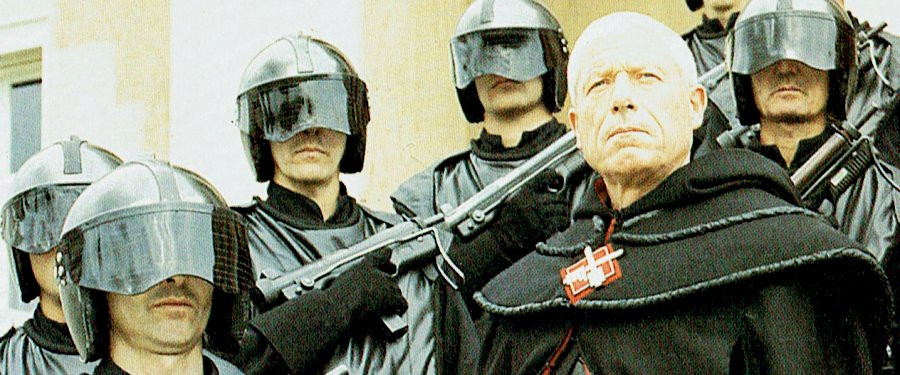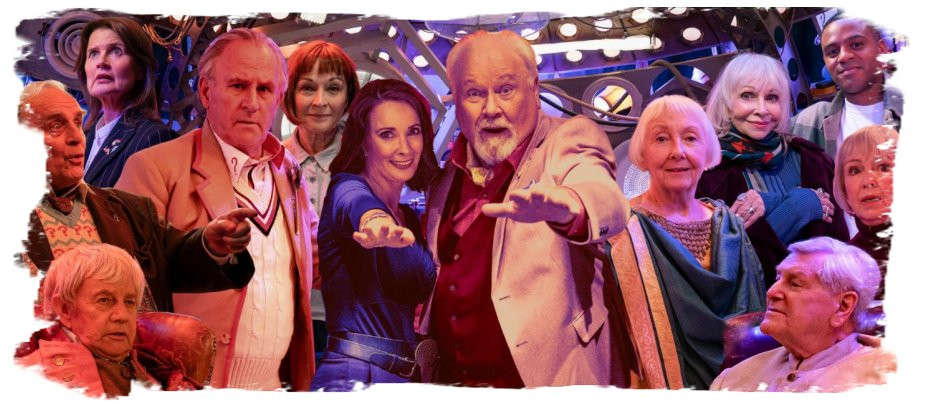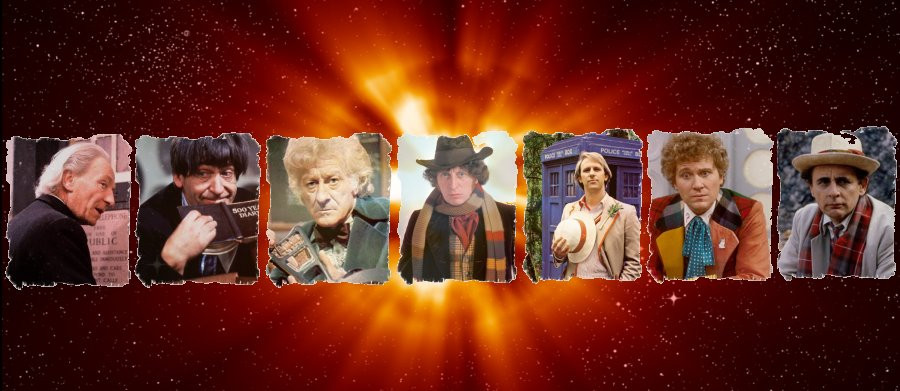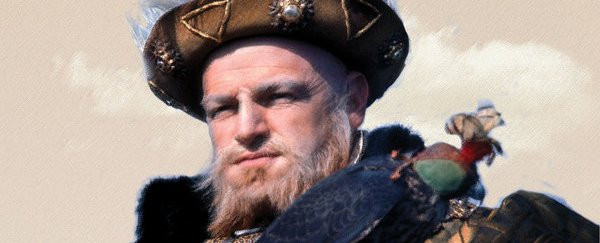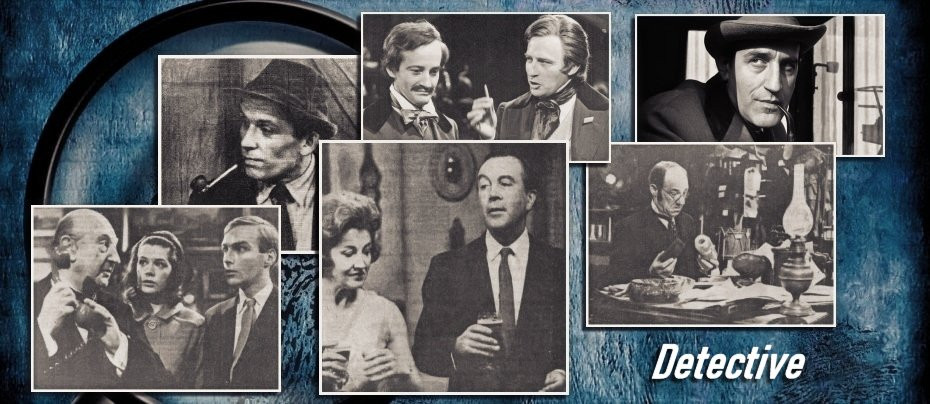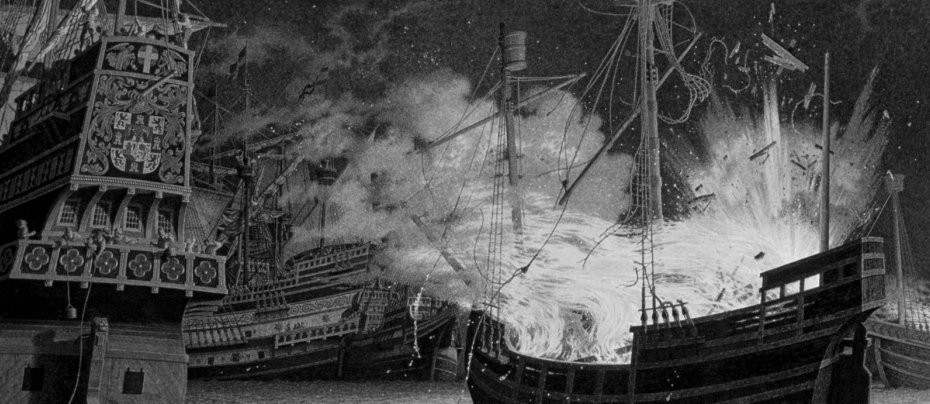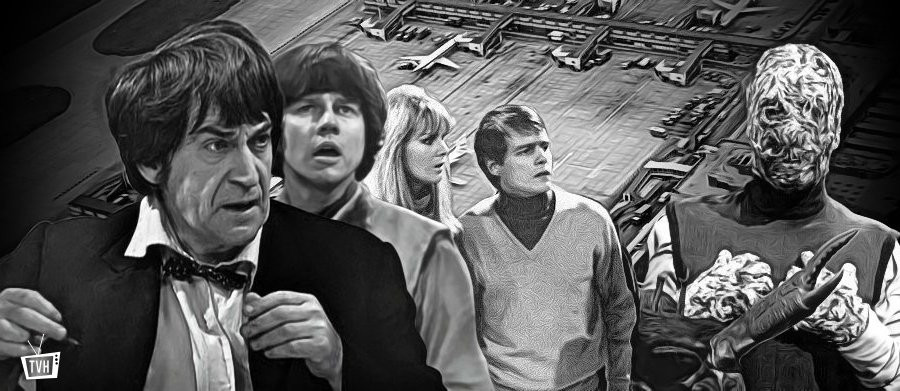
Doctor Who: The Macra Terror & The Faceless Ones
Broadcast in 1966 and 1967, the fourth season of Doctor Who wrote out the original Doctor William Hartnell and replaced him with Patrick Troughton, revamping the programme and ingeniously providing it with the secret of longevity. The series already had a well-established method of keeping things fresh by continually replacing the Doctor's travelling companions every few serials, and now they had a way of replacing the star of the show every few years. Sadly, this groundbreaking season was absolutely savaged by the BBC's archival purges in the 1970s. Even after years spent recovering copies from overseas broadcasters, only ten of the forty-three episodes of the season remain extant, and none of the nine serials is complete.
Surprisingly, though, it's possible to buy almost all of this season on DVD or Blu-Ray, thanks to some incredible work to recreate the lost episodes using animation. While the Doctor can regenerate, the programme itself can be reanimated. Two of the serials, The Macra Terror and The Faceless Ones, have been recently released in this format. Happily, they're two consecutive stories, allowing a ten episode Troughton marathon if you've a long evening in planned (and currently, haven't we all?) Both feature the same TARDIS team: Troughton as the Doctor, Anneke Wills as sixties posh totty Polly Wright, Michael Craze as Able Seaman Ben Jackson and Frazer Hines as 18th century Scotsman Jamie Macrimmon.
The Macra Terror was the third and last Doctor Who script by Ian Stuart Black, who had previously written The Savages and The War Machines for William Hartnell's Doctor, and also scripts for Danger Man, the 1950s television adaptation of The Invisible Man and the 1962 serial Sir Francis Drake. The four-part serial is entirely missing from the archives, save for a few clips, which were helpfully snipped from the programme by Australian censors and kept separately from the main film; as such, they were not returned to the BBC when their lease was over. There are also a few such clips from The Faceless Ones, but given that there are two episodes still available for that serial the clips aren't quite so treasured. It's a good thing the Australians were supposedly so squeamish in the 1960s; if the censors had been a bit bolder, they would never have cut sequences of giant crabs menacing young women and accidentally saved them.
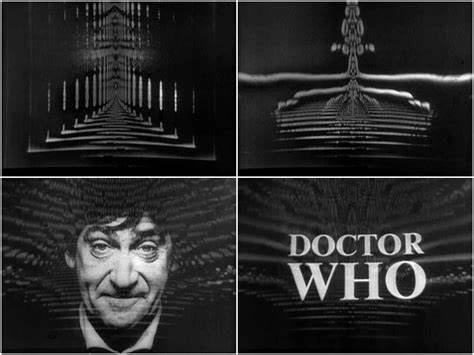
The Macra Terror boasted a few firsts for the series. For the first time, the Doctor's face appeared in the title sequence, starting a trend that continued right through the classic series and was revived for a few years for Matt Smith and Peter Capaldi. The title sequence had otherwise been unchanged since the programme started broadcasting (although the actual episode titles were sometimes presented in unusual ways). It's the also the first time the series trumpeted the name of a new monster in the story title. Sure, we like to call the first Dalek serial The Daleks these days, but that's after the fact, and there was an episode of their second serial of that title, but that was reintroducing an already successful monster. This is different: What's a Macra? You'll find out! Come see the new monster!
All of which is incidentally interesting, but the concept of the story is wonderful. On a nameless planet in the unknown future, a colony built like a holiday camp maintains rigid control over its population by means of brainwashing. The continual jingles that are played get annoying quickly (the soundtrack features some of Dudley Simpson's earliest work for the series – he'll be back a lot in the seventies) but you can imagine how they'd start affecting the colonists' minds. A mysterious Big Brother-type figure instructs the colonists through a huge monitor screen in the main complex. It's George Orwell by way of Butlin's, with mandatory fun and parades and subliminal messaging in your sleep. This was March 1967; six months later, The Prisoner started with its own terrifyingly Orwellian resort. It was the sixties; there was something in the air.
It's an interestingly archaic setting for a story. While ostensibly set in the future, the holiday camp trappings were old-fashioned relics even in 1967. Butlin's, the archetypal holiday camp chain, was founded by Billy Butlin in 1936 and saw major success following the Second World War. The chain expanded all over the UK and even beyond (there was a long-lived camp on the Bahamas). The original Skegness camp and the famous Bognor Regis camp still run under the Butlin's name (after multiple changes of hands), while others run under different names, and they're now rather different to the early concept of the holiday camp, with far more autonomy for the guests. In the sixties, the camps were still known for their old-fashioned, regimented fun, with strict rules regarding socialising between guests of opposite genders and excruciating ideas of family entertainment. These days, the concept is largely known from screen parody, and even those are old: Hi-de-Hi! Being the most famous, the 1980s sitcom set at the fictionalised version known as Maplin's, while Doctor Who itself filmed at Butlin's on Barry Island, Wales for the 1987 serial Delta and the Bannermen, and that was set in the fifties.
The Colony of this serial is clearly modelled on such camps, with marching bands, chirpy announcements and patrolling but smiling attendants all present. It's a clever combination of elements, with the controlling aspect of the camp regime extended to true social and mental control. As with The Prisoner, the old-fashioned cheerfulness of it all is just as much a source of creepiness as the mind control and the monsters.
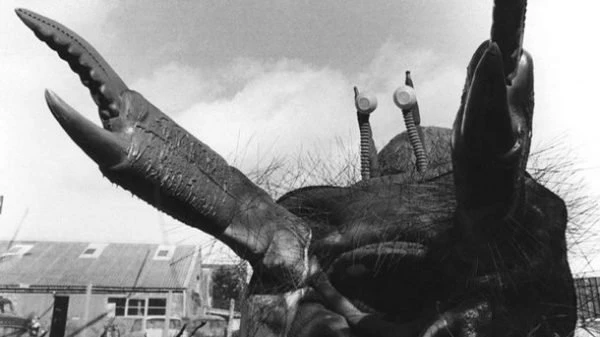
Ah yes, monsters. While it deals with some widespread sixties paranoia, and it's nowhere near as effective as The Prisoner, The Macra Terror goes one better with something only Doctor Who could do: giant crab monsters. Yes, the masterminds behind the colony are a race of huge crustacea, enormous beasts that live below ground and feed off the toxic gases that the colony mines. The script, which began as Doctor Who and the Spider-Men (Stan Lee might have had something to say about that), isn't entirely sure whether the Macra are spiders, insects or enormous bacteria, but the props make it clear that they are crabs, with enormous pincers and headlamps for eyes. It was among the last work for the series by Shawcraft Models, who had worked on the programme since its inception. The whopping great arthropods cost £500, an absolutely astonishing amount of money at the time, but they couldn't actually move very much.
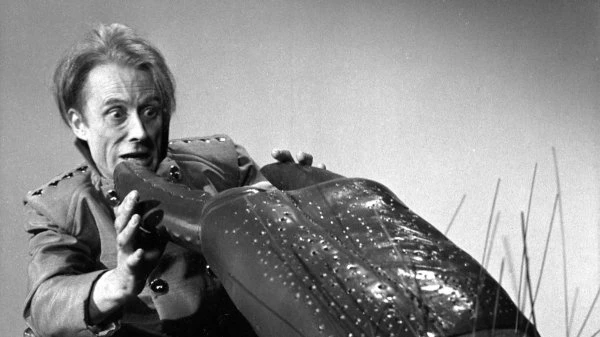
The Macra are, according to some guidebooks, named for the enormous crustacean species Macrocheira kaempferi, the Japanese spider crab, which are genuinely much more frightening than the Doctor Who monsters. On the other hand, I'm fairly convinced it's just short for MAssive CRAbs. It's not even entirely clear whether the creatures are truly intelligent, or simply acting towards some kind of social instinct, but the result is the same, with the alleged Controller issuing commands and propaganda even as the Macra control him. Played by Graham Leaman (who went onto several more Doctor Who roles and previously known for Hancock's Half Hour and No Hiding Place) the Controller is well realised, increasingly hysterical - insisting that "There are no Macra! Macra do not exist!" as the truth slowly becomes known.
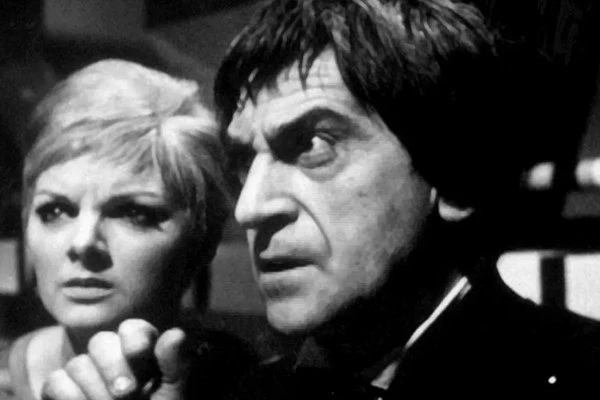
It's a clever exploration of the power of suggestion. The Doctor's three companions are subjected to subliminal indoctrination while they sleep, with different effects. Ben, as a career sailor, is used to following orders and falls easily under the influence, handing the Doctor in and convincing himself that there are no Macra even after he's rescued Polly from one of them. Polly falls under the influence, but unlike Ben she's quite easily snapped out of it by a little cajoling from the Doctor. Jamie, on the other hand, although often written as less bright than the others, is immediately mistrustful of the Colony's overseers and fiercely loyal to his friends, refusing to be affected by the indoctrination. He'll be with Troughton's Doctor right to the end, of course, and his loyalty to him is what keeps him safe here.
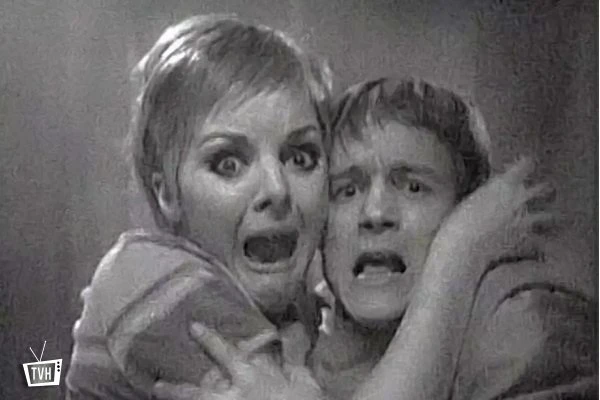
The Doctor himself is as wonderful as always, with Troughton putting in a twinklingly charming performance. There's a particular joy in seeing him solve a mathematical puzzle that has been left unfinished and mark himself ten-out-of-ten, only to learn that the Colony's computers have just solved it after months of work, and then up his score to eleven. The most anarchic of Doctors falls in quickly with the rebel Medok (Terence Lodge – An Age of Kings, Doctor Faustus) a dishevelled young man who has discovered the existence of Macra and is sentenced to work in the deadly gas mines as punishment for spreading disinformation. He's rather good, as is Peter Jeffrey as the Pilot – the official administrator of the Colony, presumably following the command structure of the ship that brought them there. Jeffrey, known for roles such as Oliver Cromwell in The Sword Divided, appeared again in Doctor Who in the 1978 serial The Androids of Tara as the villainous Count Grendel. The mightily-nosed actor was also one of several considered to take over as the Doctor from Hartnell, had Troughton not taken the role. Also memorable is Gertan Klauber (Poldark, Blackadder the Third and various Carry On... productions) as the oily Chief of Police.
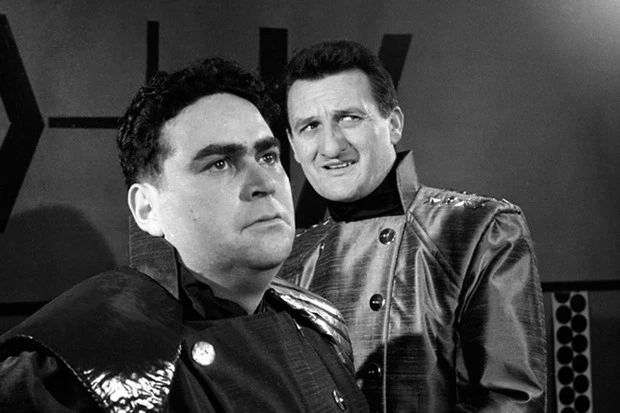
The Macra Terror isn't the greatest of Troughton's many Doctor Who serials, feeling rather old hat watched now, but it remains an entertaining piece of paranoid lunacy spiced up by the inclusion of the monsters themselves. In practical terms, the Macra are the weak link; from what footage remains, they're far too cumbersome and immobile to really work on screen, although director John Davies does quite well with them. The Macra would likely have remained one-off, Z-list monsters were it not for Russell T. Davies, who resurrected them to appear, in redesigned and computer-animated form, in the David Tennant Doctor Who episode "Gridlock" in 2007, almost exactly forty years after their first appearance.
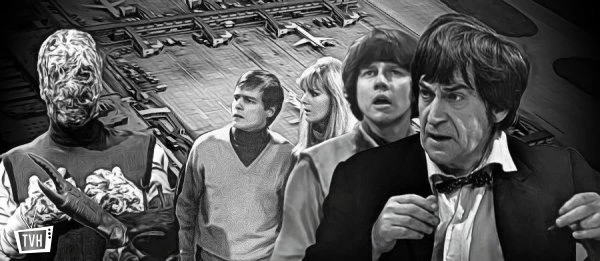
The Faceless Ones was written by Malcolm Hulke (The Avengers, Pathfinders in Space, Danger Man) and David Ellis (Paul Temple, Spy Trap, Dixon of Dock Green). Both had submitted several story ideas to the production office before joining together to submit some further ideas, which included The Big Store, an outline that involved living shop window dummies and people having their identities stolen. The setting was entirely reworked for what eventually became evocatively-titled The Faceless Ones, leaving the mannequin idea ripe for pinching for Jon Pertwee's first serial, Spearhead from Space, filmed in 1969. Instead of a department store, The Faceless Ones takes place at Gatwick Airport – the real deal, in fact, filmed at the airport itself.
This, for many British viewers today (and naturally, a fair few overseas ones), provides a remarkably familiar experience when watching the serial. I can't tell you how many times I have visited Gatwick (my closest international airport) so seeing it here with the Doctor and his chums running around is an interesting experience, similar to when you see an episode of a favourite show unexpectedly take place in your hometown. One thing that stands out though, and is remarked upon repeatedly in the cast commentary on the Blu-Ray release, is how empty the airport is. Although London Gatwick (to give its correct name) has been servicing commercial flights since 1933, in the sixties the international holiday boom was just beginning. Families were still just as likely to drag their kids to a holiday camp as they were to travel overseas, and most such trips were prohibitively expensive for the average family. However, air travel was becoming cheaper and package holidays, which could almost as regimented as Butlin's but at least took you to some interesting places, had arrived, making such trips more affordable. Gatwick is a familiar environment now, but would have been as alien as the planet Skaro for many watching in the sixties.
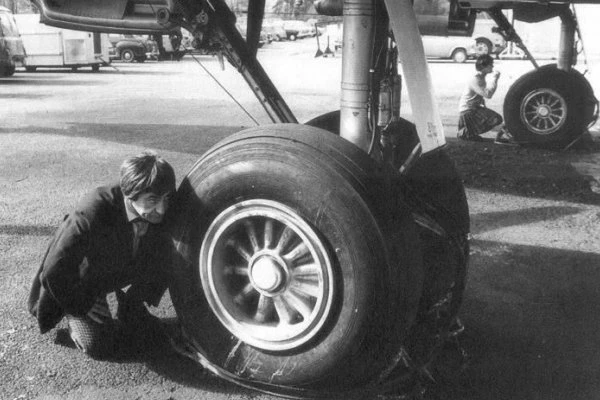
So, while The Macra Terror took something old-fashioned and used it as a way to explore a contemporary fear, The Faceless Ones was as modern as it gets in 1967. The story involves young people's identities being usurped by means of abduction as they board planes to go on package tours. It's the sort of up-to-date idea that Swinging Sixties companions Ben and Polly had been invented for. This makes it rather odd, then, that they're barely in it, but we'll come back to that. Air travel was an exciting modern treat that was, nonetheless, quite frightening. Unless they'd been in National Service, most young people had never left their own country before going on one of these tours, and were expected to put their lives in the hands of pilots, attendants and handlers as they travel at frightening speeds and velocities. Air travel was new and scary, but this still holds today. It's not surprising that so many people are still afraid of flying; it is, after all, unnatural. As one memorable Assistant Captain said on a Virgin Air flight I was one some years ago, "The next time you feel the urge to hurtle through the air at 30,000 feet in a pressurised metal tube, we hope you think of us." The recent obsession with the risk of terror attacks and takeovers on planes, following the September 11th attacks nearly twenty years ago, only makes it more so.
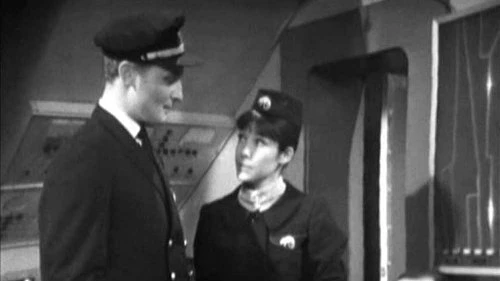
Equally is the fear of identity theft prescient, being a much bigger concern today than it was in the sixties. The idea that you can become an "un-person" due to your identity being compromised, or that someone could take on your identity and use it for their own nefarious ends, is all the more real in an age when our lives are so wholly computerised. The Faceless Ones is in the unusual position of being both extremely 1960s in its concerns and timely for a modern audience.
The Faceless Ones is a six-part serial, and today only the first and third episodes remain in the archives. It's always a stroke of luck when an opening episode survives, given how important they are to establishing the setting and atmosphere. The TARDIS materialises right in the middle of a runway, leading to the understandable concern of the airport police. Rather than try to bluff his way through and explain their presence, as he usually would, the Doctor tells everyone to scatter, which obviously makes them all look guilty as anything. Polly immediately stumbles onto a murder scene, where one of the airport staff zaps some poor unfortunate with a ray gun. The victim turns out to be a police detective who's been investigating Chameleon Tours , who have been responsible for the apparent disappearance of several youths on their trips.
Ben and Polly both gets themselves abducted in pretty short order, essentially writing them out of the plot for the bulk of the serial. Anneke Wills gets to spend some time as Polly's alien alter ego, appearing as a tourist who insists she's a Swiss woman named Michelle Leuppi and refusing to recognise the Doctor or Jamie. She then starts working as a front-of-house representative for Chameleon Tours, which shows up some holes in the aliens' logic. It turns out that the aliens, who call themselves Chameleons (although this is likely not their original name) all lost their identities in "a gigantic explosion." What this means is guesswork, really, although given that the aliens have been left horribly scarred and mutated, we can probably assume it was a nuclear accident or attack of some kind (another common fear in the sixties). The beings aren't invading the Earth, as such; they're using the tour company to get young people onto aircraft which are actually spaceships, whereby they can miniaturise them and take them back to their own planet, and use them as the basis of new, healthy bodies and identities.
Clearly, a logical plot wasn't exactly the primary concern here. Given that the Chameleons are taking over people's identities, why on Earth does one take over Polly's and then pretend to be someone else? Possibly they're trying to discredit the Doctor by making him look unhinged, which is pretty plausible, but it's a very funny way to go about things. There are some unintentionally hilarious lapses in common sense throughout, such as the marvellous scene where both the Doctor and Jamie hide their faces behind newspapers while airport security are looking for them. Aside from the that the illiterate Jamie holds his upside-down, they're looking for a bloke in a top coat and baggy trousers, and a boy in a tartan kilt. Didn't his knees give him away? There are sundry traps and attempts on the Doctor's life, including a part where the villains tie them up and leave them to be killed by a laser beam that's very slowly making its way towards them. It's absurd Bond villainy at its best, or worst, if you prefer.
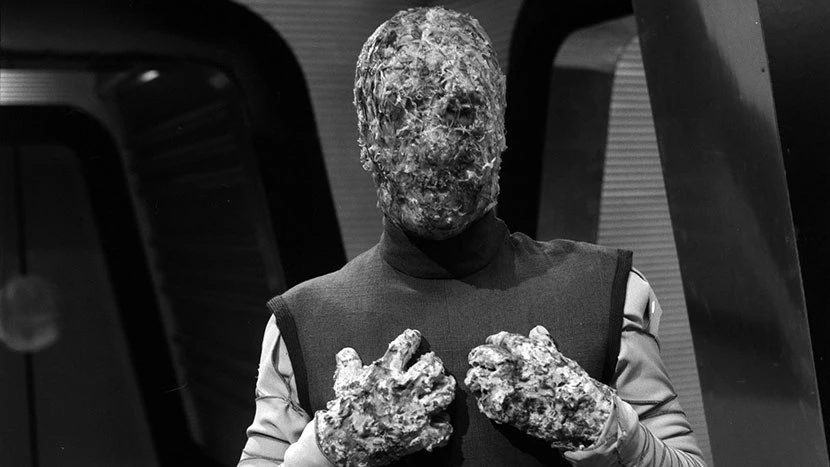
The story works in spite of, or rather because of, this silliness. One thing that's easy to notice about both this serial and The Macra Terror is that they'd be comfortably at home as episodes of The Avengers or a similar adventure series. Swap the Chameleons for a Soviet spy organisation, and make the Colony an actual holiday camp taken over by an extremist collective, and both stories would fit perfectly in a more earthly but equally absurd series. You'd have to lose the giant crabs, of course, but the point is that the contrivances and silliness are all part of the fun. It doesn't take anything away from the creepiness or sinister atmosphere. It's a shame that the Chameleons are seen so little in their natural guise in the surviving episodes, since the glimpses we get are really unsettling. Blank, scarred and warped faces, veined and damaged hands, they're a nasty-looking bunch. As well as the spy fiction and paranoias of the time, there's clearly an influence here from some of the science fiction of the 1950s. Invasion of the Body Snatchers is a clear precedent, as is Quatermass II, but there's something rather pitiful about these alien insurgents. They come across as more desperate than truly villainous, and in the end, the Doctor comes down very lightly on them, even offering his help in finding a cure for their condition. There's an argument to be made that the serial is about fears of immigration and refuge, but if that's the case, it's ultimately on the side of the refugees. This even-handed, sympathetic approach to villains is typical of Hulke's writing, and visible in his many of his later scripts for the series, including Doctor Who and the Silurians, The Ambassadors of Death and Invasion of the Dinosaurs.
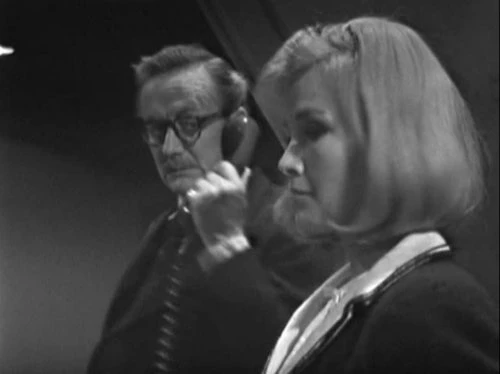
Troughton's Doctor is always at home bucking authority, but he works just as well here when he gets the authorities tenuously on his side and begins investigating with them. Colin Gordon (Don't Tell Father, The Baron, Complete and Utter History of Britain) plays the airport Commandant, a refreshingly open-minded man who changes his opinions when provided with evidence of the aliens' presence. A young Wanda Ventham (UFO, Emmerdale Farm and much, much more) plays his secretary, Jean Rock, who becomes a short-term sidekick to the Doctor in his plans to expose the Chameleons. Donald Pickering (The Pallisers, The Newcomers) puts in a good performance as the entertainingly named Captain Blade, or rather, his Chameleon alternative. Pickering and Ventham would appear together on Doctor Who again in 1987's Time and the Rani with Sylvester McCoy.
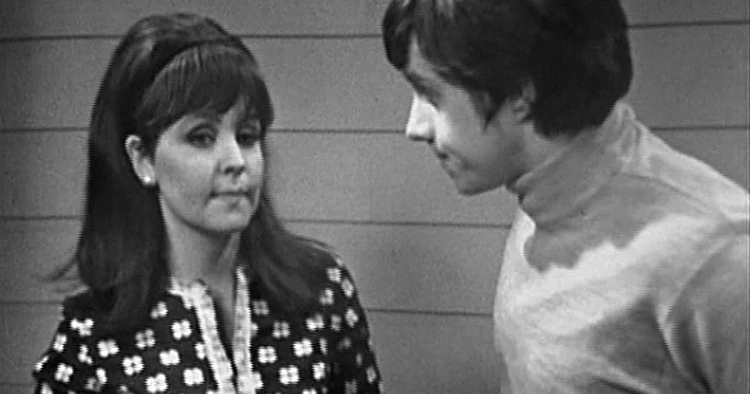
The most significant guest star, though, is Pauline Collins as Samantha Briggs, some years before her huge success as Shirley Valentine but already well-established. A brassy but vulnerable Liverpool lass, with more than a hint of Cilla Black to her (I'm sure they'd have cast her if they could), Sam is on the trail of her missing brother, and becomes both a temporary part of the Doctor's team and a love interest for Jamie (she clearly fancies the kilt off him). Jamie, for his part, is suddenly rather more confident around girls than he was in any of his previous stories, so something must have happened between this and The Macra Terror. (I reckon he and Polly had a brief thing – no wonder Ben seems a touchy mood.) Collins impressed the producers so much that she was offered the chance to stay on as the new companion in place of Ben and Polly. This sort of on-the-fly casting wasn't uncommon on the programme at the time – Hines had been cast as Jamie as a one-off character on The Highlanders earlier in the season, before being kept on – but Collins turned the offer down. She did, however, return to Doctor Who as Queen Victoria in the 2006 episode "Tooth and Claw" opposite David Tennant's Doctor.
With Sam and, to a lesser extent, Jean filling in much of the companion role, it's not surprising that Ben and Polly are side-lined. Ben gets in a little investigative time with the Doctor and Jamie before his own disappearance, but he's ultimately hardly in it. It's clear from watching the serials of this period that, once the decision had been made to keep Jamie on, there wasn't much room for Ben as well. Polly could have lasted longer, but Wills was keen to try other things, and so the two were written out together. They reunite with the Doctor and Jamie at the very end of the serial, realising that they've had the good fortune of landing on the very same day they left with the Doctor in their first appearance on The War Machines. So they say goodbye and leave the Doctor and Jamie to it. Wills went on to play Evelyn McLean on The Strange Report, but largely stopped acting after that, focusing on her family and later travelling the world, although she later returned to the role of Polly for Big Finish's Doctor Who audio series. Craze went onto roles on Hammer's Journey to the Unknown and several horror films, and continued to work in television into the nineties. Sadly, he died from heart failure in 1998, aged only fifty-six.
The Faceless Ones is one Troughton's most enjoyable Doctor Who serials, although, like many six-parters, it does drag a little in the middle. A mix of arresting visuals and brilliant central concept make the story work in spite of the logistical nonsense, but it's mainly a background for the Doctor and Jamie to show why they're such a classic TARDIS team. While it's treatment of Ben and Polly is unfortunate – they really deserved more screen time in their last story – Sam Briggs actually works rather well as a temporary companion and foil to Jamie. The production is visually impressive, partly down to the filming in the airport but also some decent modelwork for mocked-up elements. However, after the Macra debacle, Shawcraft Models finally outstayed their welcome with this story, when their model of the Chameleons' satellite was not only not up to scratch, but also collapsed and crashed to the ground during filming. That was that for the company when it came to Doctor Who; all subsequent serials employed the BBC's own visual effects team.
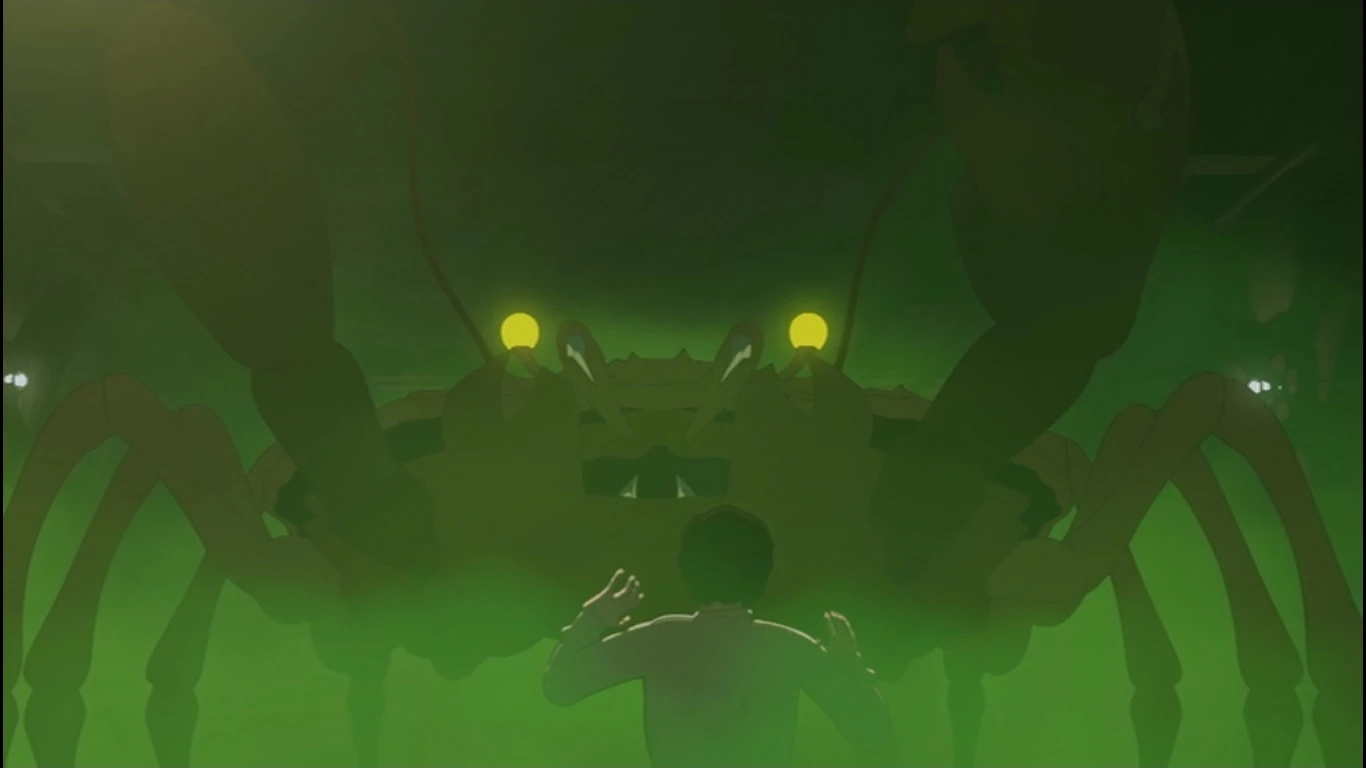
While largely missing from the archives, there have been several ways to enjoy both The Macra Terror and The Faceless Ones over the years. The full soundtracks exist for all sixties Doctor Who serials thanks to some diligent (and technically illegal) fan recording work, while both stories were novelised in 1987 as part of the Target range of books, with Black novelising his own script while the prolific Terrence Dicks reworked The Faceless Ones. Both have been released as audiobooks as well. However, the best way to enjoy them is the recent animated versions, both currently available to own. In both cases the entire serial has been recreated, and can be presented either in colour or, if you're a purist, black-and-white. (Why this requires a separate disc is beyond me.) The release of The Faceless Ones includes the option of watching with the existing episodes, which have themselves undergone extensive restoration work.
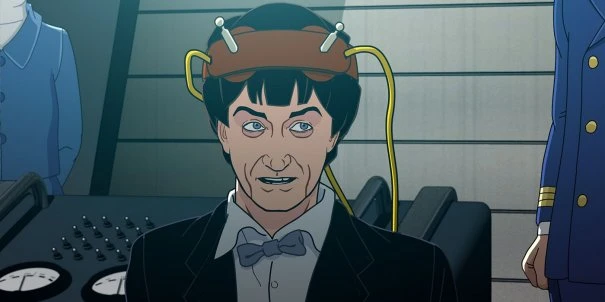
Both animations are excellent, supplemented by existing footage for comparison. The Macra Terror in particular benefits from the change in format, with the Macra being far more mobile, threatening and believable in animated form. On the other hand, the animation cuts out certain scenes, including a beautiful moment when the Doctor is tidied up by a dressing machine, only to run himself through a "rough-and-tumble" muscle-toning machine to get himself all scruffy again. I can recommend the two releases wholeheartedly to any fans of the Second Doctor. Troughton's era of Doctor Who is slowly being restored to completion in this fashion, with The Power of the Daleks, The Moonbase, The Ice Warriors, Fury from the Deep and The Invasion now available and the missing third episode of The Web of Fear currently being worked on. Eventually, we should be able to sit down and enjoy the entire era.
Review: Daniel Tessier
Dan describes himself as a geek. Skinny white guy. Older than he looks. Younger than he feels. Reads, watches, plays and writes. Has been compared to the third, fourth, fifth, sixth, seventh, eighth, tenth, eleventh and twelfth Doctors, and the Dream Lord. Plus Dr. Smith from 'Lost in Space.' He has also had a short story published in Master Pieces: Misadventures in Space and Time a charity anthology about the renegade Time Lord.
Dan's web page can be here: Immaterial
Published on January 20th, 2021. Written by Daniel Tessier for Television Heaven.



